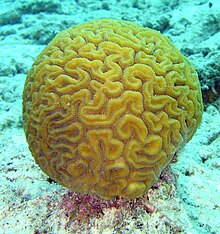Loading AI tools
Genus of corals From Wikipedia, the free encyclopedia
Diploria is a monotypic genus of massive reef building stony corals in the family Mussidae.[3][4][5][6] It is represented by a single species, Diploria labyrinthiformis, commonly known as grooved brain coral and is found in the western Atlantic Ocean and Caribbean Sea.[7][2][8][9] It has a familiar, maze-like appearance.
| Diploria | |
|---|---|
 | |
| Scientific classification | |
| Domain: | Eukaryota |
| Kingdom: | Animalia |
| Phylum: | Cnidaria |
| Class: | Hexacorallia |
| Order: | Scleractinia |
| Family: | Mussidae |
| Genus: | Diploria Milne-Edwards and Haime, 1848 |
| Species: | D. labyrinthiformis |
| Binomial name | |
| Diploria labyrinthiformis (Linnaeus, 1758)[2] | |
| Synonyms | |
|
List (Species)
| |

This species of reef-building coral has a hemispherical, brain-like shape with a brown, yellow, or grey colour.[8] It has characteristic deep, interconnected double-valleys. These polyp-bearing valleys are each separated by grooved ambulacral ridges. There may be a difference in colour between the valleys and the grooves.[10]
Diploria labyrinthiformis can grow upward at a rate of approximately 3.5 millimeters per year, achieving about 2 metres (6.6 feet) in diameter. During its planktonic larval stage, the coral has locomotion. After that time, it becomes permanently sessile.[11]
This species is a suspension feeder, and survives mainly on zooplankton and bacteria. These are captured by the polyps, by extruding mesenterial filaments and tentacles. The polyps have nematocysts which are triggered to hold their prey immobile. The prey is then transported to the mouth with the assistance of mucus and cilia.[11]
Diploria labyrinthiformis is hermaphroditic, and reproduces through broadcast spawning. This entails eggs and sperm being released by adult colonies, followed by fertilization and the development of larvae at the water surface. Unlike most other Caribbean broadcast spawners, Diploria labyrinthiformis spawns over multiple months from the late spring until even mid-autumn.[12]
Diploria labyrinthiformis is found in tropical parts of the west Atlantic Ocean, the Gulf of Mexico, the Caribbean Sea, the southern tip of Florida, the Bahamas, Bermuda and the coasts of Central America.[1][2][13]
This coral occurs offshore at depths ranging from 1 to 30 metres (3.3 to 98.4 feet).[11]
The Diploria coral is important to its environment because it helps researchers see how the oceans temperature has changed over time by looking at the layers in the coral skeleton.[14]
This species was listed as Least Concern for years on the IUCN Red List, however the most recent assessment in 2021 has resulted in a sudden uplisting due to the species' predicted decline, in part due to its susceptibility to Stony Coral Tissue Loss Disease.[15]
Diploria labyrinthiformis hosts Zooxanthella, a symbiotic dinoflagellate alga. The alga benefits from being in a protective environment in an elevated position. The coral benefits from the nutrients produced photosynthetically by the alga which provides part of its needs for growth and calcification.[11]
The coral also has a relationship with Diadema antillarum, the long-spined urchin, whose grazing helps to reduce the effects of shading, as well as the overgrowth of macroalgae.[11]
Despite the polyps being equipped with nematocysts, various species prey upon Diploria labyrinthiformis. These include:[11]
This species is host to a parasite in the Corallovexiidae family:[2]

In the past, other species were classified as pertaining to the Diploria genus. Some of those species are now classified as Pseudodiploria, a genus erected in 2012, such as P. strigosa and P. clivosa.[16]
Diploria labyrinthiformis is hermaphroditic, employing a broadcast-spawning method to reproduce. As with most coral species, timing of gamete release is related to moon cycles.[17] Exact timing of this event can vary, even within its regional range, but is typically earlier in the year than many other scleractinian species in the Caribbean [18]
Images of Diploria labyrinthiformis appear on three postage stamps: a 75 cent Belizean stamp created by Georges Declercq,[19] a 15 cent stamp from United States issued 1980-08-26 and a 54 Euro cent stamp from Mayotte.[20]
Seamless Wikipedia browsing. On steroids.
Every time you click a link to Wikipedia, Wiktionary or Wikiquote in your browser's search results, it will show the modern Wikiwand interface.
Wikiwand extension is a five stars, simple, with minimum permission required to keep your browsing private, safe and transparent.